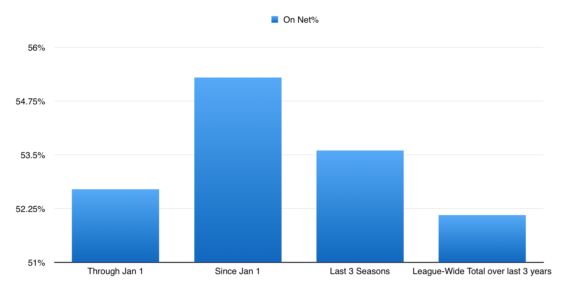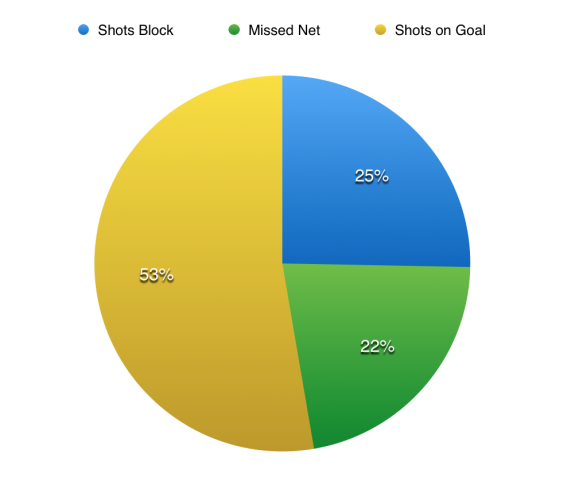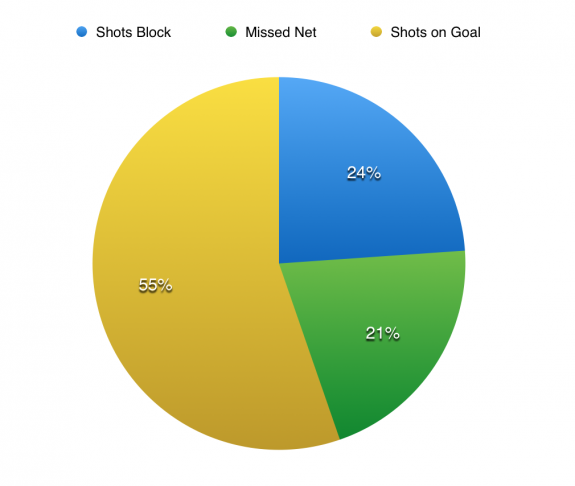In part I of this series we looked a little bit at shot quality to see if that’s part of the decline in the Minnesota Wild’s shooting percentage. The answer was “it’s complicated,” and it gets more complicated the deeper you dig into it.
The Wild’s season is spiraling out of control. They’ve lost nine of their last 10 games and have lost three straight games where they scored first.
Part of the issue in assessing shot quality is that there are many ways to define it. Each of those perspectives is valid, but says something different about the team’s play.
Another problem arises when you try to separate information about shot quality that is predictive versus just telling us what did happen. Is one kind of success repeatable and can we use that repeatability to find systems or methods that work in generating high quality shots in a repeatable manner?
We’re not going into that now. That’s a major research project. But it gets at some of the problems we encounter when we want to talk about shot quality. That’s without getting into the issues with individuals — a Steven Stamkos shot has a higher chance of going in than a David Schlemko shot — or adjusting for ways that a great cross-ice pass (or other puck movement) can make what would otherwise be a medium-quality shot into a high-danger shot.
Again, that’s a very large topic, but trying to hone in on shot quality can be complicated. But let’s see if we can learn anything from looking at what has happened with the Wild’s shot quality from the start of the season through the end of 2015 as compared to what has happened to the Wild in 2016.
Scoring Chances
In the first part of the series we looked a bit at the Wild’s scoring chances, as defined by War on Ice.
The primary concern here was not just that their shot attempts in total have gone down during the slump, but that their scoring chances have as well. They went from a 22nd ranked 24.6 scoring chances per 60 minutes of even strength play (SCF60) to a 28th ranked 22.5 since the first of the year.
That’s not just a reduction in scoring chances, but it also shows that scoring chances, as a percentage of their total shot attempts, have gone down. From the start of the season through the end of 2015 about 48.3% of their shot attempts were scoring chances. Since the first of the year, that has dropped to 47.1%.
In a couple different ways we’re seeing reduced scoring opportunities coming from the Wild, both in the potential quality of an individual shot and in the total number of quality shots taken.
That’s a small difference, but over a longer span that begins to matter more. Furthermore, it definitely matters when you’re having troubles scoring and have the league’s worst shooting percentage in 2016.
Hitting the Net
There’s some reason to believe that hitting the net on a shot attempt is a repeatable skill. Statistically, it’s not as easy to prove as you might guess when you’re yell “Shoot the puck Granny!” at your TV.
This is a type of quality inside shot attempts. Inarguably, a shot attempt that becomes a shot on net is a higher quality shot than a shot that misses the net or is blocked.
So, how are the Wild doing at hitting the net?
As a baseline, shots on goal represent 53.6% of their shot attempts over the last three seasons. To start the season, they were hitting the net less frequently than that baseline with shots on net representing 52.7% of shot attempts. Now, converse to what we see above, shots on net represent 55.3% of shot attempts.
Is this the “hanging onto the puck too long” that Mike Yeo was talking about? (See Yeo quote in first section of this post.) It could be. Reduced shot attempts could stem, to a small extent, from not getting some of those shot attempts off while hanging onto the puck for a chance to really place on on net. That could drive down total shot attempts while driving up the percentage of shots on net, particularly in a sample as small as we’re looking at.
But it also shows some increased quality. Here’s how those percentages look, including the on net percentage of all NHL shot attempts over the last three seasons.

To break that out a little more, here are how all shot attempts for the Wild break down from the start of the season through the end of 2015, followed by how shot attempts break out in 2016.


Does It Make a Difference?
Looking at the Wild’s shot quality is messy because of the variety of ways to define quality.
What we can conclude is that they’re getting fewer scoring chances and the potential of any given shot attempt being a scoring chance has gone down. That’s a bad situation.
More of their shot attempts are hitting the net, which is a different kind of quality, but it’s tough for that to subsume their shooting percentage problems when their shot attempts are dropping. It’s not a bad sign overall, but it really needs to be seen on a larger sample and with their shot attempts rates higher for it to make much of an impact.
They’ve been near the bottom of the league in scoring chances all season. Their shot quality is not improving — in fact it’s probably getting worse by a small amount.
Ultimately, they don’t produce enough shots and haven’t all year. Shot quality could help put some pressure on the open wound, but with questions about repeatability outside of just hitting the net, they need to focus on getting more rubber on the net rather than getting better chances. Even with a reduced percentage of shot attempts being scoring chances, the dire need is to create more shot attempts.
RELATED:
What’s Wrong With the Wild, pt. I: Everything
Jarrett Stoll Changing Fourth Line Philosophy in Minnesota
Advanced stats via War on Ice. All Corsi numbers score-adjusted.